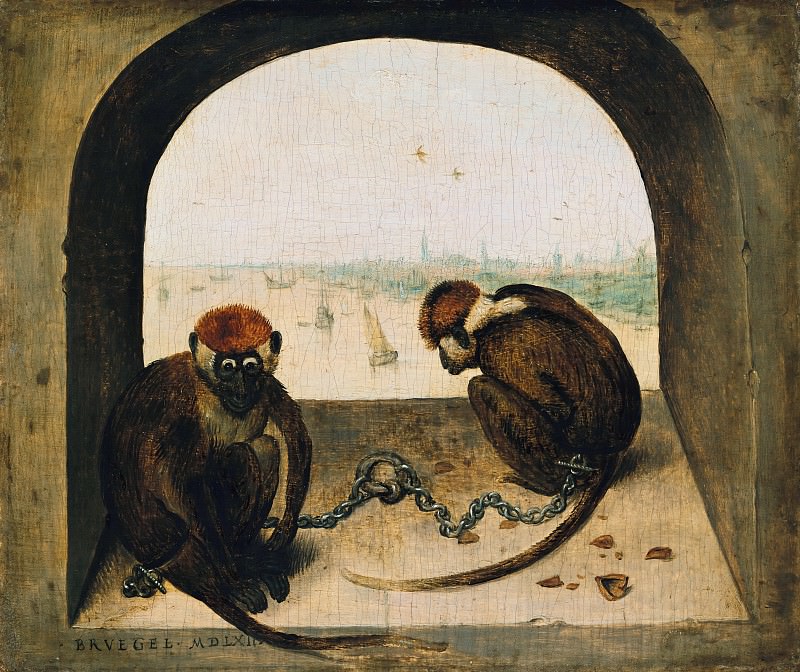Pieter Bruegel I (c.1525-1569) – Two Chained Monkeys Part 4
Part 4 – Pieter Bruegel I (c.1525-1569) - Two Chained Monkeys
Edit attribution
Download full size: 3662×3073 px (4,6 Mb)
Back to album: Part 4
Peter Brueghel the Elder’s painting Two Monkeys (Two Monkeys on a Chain) was painted in oil on wood in 1562. The genre is animalistic. The plot is based on two brown monkeys chained to the same ring. They sit on a wide, low window that offers a view of Antwerp, the sea bay with ships, towers and houses lost in the fog. The animals and the chain are the most striking images of the work. They are drawn in detail and vividly.
Description of the painting "Two Monkeys" by Peter Brueghel the Elder
Peter Brueghel the Elder’s painting Two Monkeys (Two Monkeys on a Chain) was painted in oil on wood in 1562.
The genre is animalistic.
The plot is based on two brown monkeys chained to the same ring. They sit on a wide, low window that offers a view of Antwerp, the sea bay with ships, towers and houses lost in the fog. The animals and the chain are the most striking images of the work. They are drawn in detail and vividly. One animal turns to the viewer, however, his almost human gaze is directed inward, into the depths of his soul. Their lostness and loneliness is evidenced by their huddled, hunched postures. They turn away from each other. Even when close, they do not stick together, do not support each other.
The inclination of their heads, their features, their postures, their tails drooping freely, reveals their longing, apathy, despair, and the understanding that it is impossible for them to be free. The birds soaring over the sea create a contrast - in contrast to the chained animals, the will is available to them. Interestingly, the birds fly in pairs, repeating the image of the two animals.
Another contrast is created by the massive window opening and the graceful, transparent image of nature and the city outside the window. The landscape in the background is painted in soft gentle tones. It is characterized by lightness, a certain melancholy, sadness in contrast to the heaviness, monumentality and immobility of the walls and window sill.
The work is a symbolic representation of sin and base instincts. The monkeys appear as the embodiment of the vices of recklessness, licentiousness, and frivolity. The chain holding them down aims to tame transgressions and base desires. The empty nut shell is all that is left of the former, filled, but now ruined life.
Perhaps the painting is autobiographical and relates to the author’s love affair with some maid and his departure from Antwerp.
The work is preserved in the State Museum in Berlin.
Кому понравилось
Пожалуйста, подождите
На эту операцию может потребоваться несколько секунд.
Информация появится в новом окне,
если открытие новых окон не запрещено в настройках вашего браузера.
You need to login
Для работы с коллекциями – пожалуйста, войдите в аккаунт (open in new window).



















You cannot comment Why?
Perhaps it’s a painting of two monkeys sitting on a ledge with a chain in the foreground and a view of a body of water in the distance in the background.